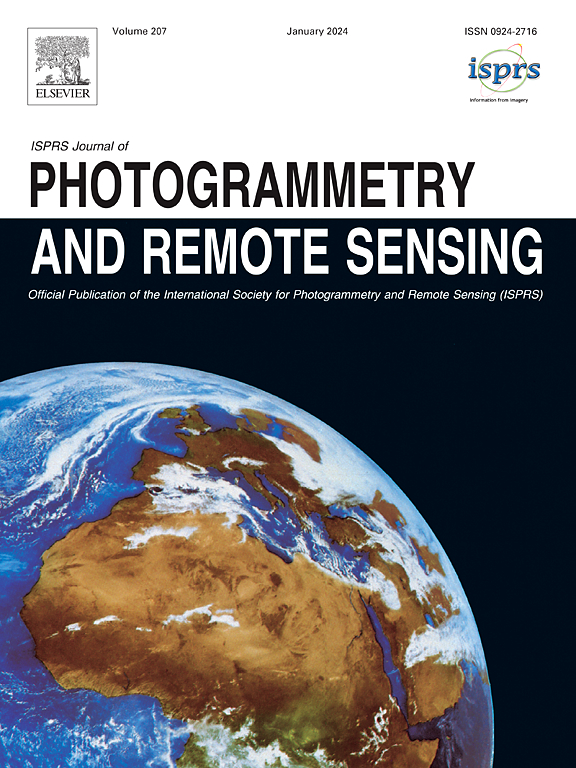A universal physically-based topographic correction framework for high-resolution optical satellite data
IF 10.6
1区 地球科学
Q1 GEOGRAPHY, PHYSICAL
ISPRS Journal of Photogrammetry and Remote Sensing
Pub Date : 2025-06-27
DOI:10.1016/j.isprsjprs.2025.05.027
引用次数: 0
Abstract
Surface reflectance, retrieved via atmospheric correction from top-of-atmosphere (TOA) observations, characterizes the intrinsic properties of the Earth’s surface. Despite its importance, topographic effects are often neglected in surface reflectance retrievals, introducing significant uncertainties, particularly over mountainous regions. Existing topographic correction methods, while numerous, commonly face challenges: physically-based approaches require accurate atmospheric parameters (often unavailable in complex terrains) and are computationally intensive, whereas semi-empirical methods depend on empirical parameters that can lead to overcorrection or inconsistent performance across diverse conditions. Additionally, prior studies have predominantly utilized data from a single satellite platform, limiting the applicability and transferability of topographic correction algorithms across diverse datasets. To overcome these limitations, we introduce a Universal Topographic Correction (UTC) framework, a physically-based approach designed for seamless integration with multiple high-resolution satellite and airborne datasets. The UTC integrates spectral information from extensive radiative transfer simulations with image-derived spatial information to optimize spectral direct irradiance ratios, a key component of physically-based correction, while accounting for shadow effects and digital elevation model (DEM)-induced errors through targeted processing along shadow boundaries. We evaluated UTC’s performance against established methods, including C-correction, SCS + C, and Statistical-Empirical (SE), using a 3D radiative transfer model as a reference across varied topographic and illumination conditions. Results show that UTC consistently outperforms these methods, particularly in shadowed areas, with mean absolute deviations in the near-infrared band of 0.0103 for UTC compared to 0.0179 (C), 0.0362 (SCS + C), and 0.0311 (SE). Testing across Landsat 9 (30 m), Sentinel-2 (20 m), SPOT 4/5 (10–20 m), PlanetScope (3 m), and AVIRIS-3 (∼2.9 m) datasets further demonstrates UTC’s robustness, effectively reducing overcorrection in complex terrains and improving reflectance accuracy in shadowed regions. UTC’s advantages lie in (i) requiring no external atmospheric inputs, and (ii) its physically-informed design based on spectral and spatial information for broad applicability. This study underscores critical limitations in existing topographic correction methods and proposes a robust solution for addressing them. Future research could enhance the UTC framework by integrating atmospheric effects, thereby achieving combined atmospheric and topographic correction from top-of-atmosphere observations.
高分辨率光学卫星数据的通用物理地形校正框架
地表反射率是通过大气校正从大气顶(TOA)观测中获得的,它表征了地球表面的内在特性。尽管地形效应很重要,但在地表反射率反演中往往忽略了地形效应,带来了很大的不确定性,特别是在山区。现有的地形校正方法虽然众多,但通常面临挑战:基于物理的方法需要精确的大气参数(通常在复杂地形中不可用),并且计算量大,而半经验方法依赖于经验参数,可能导致在不同条件下的过度校正或性能不一致。此外,先前的研究主要利用单一卫星平台的数据,限制了地形校正算法在不同数据集上的适用性和可移植性。为了克服这些限制,我们引入了通用地形校正(UTC)框架,这是一种基于物理的方法,旨在与多个高分辨率卫星和机载数据集无缝集成。UTC将来自广泛辐射传输模拟的光谱信息与图像派生的空间信息集成在一起,以优化光谱直接辐照比,这是基于物理校正的关键组成部分,同时通过沿阴影边界的目标处理来考虑阴影效应和数字高程模型(DEM)引起的误差。我们使用3D辐射传输模型作为参考,在不同的地形和照明条件下,根据现有的方法(包括C校正、SCS + C和统计经验(SE))评估了UTC的性能。结果表明,UTC在近红外波段的平均绝对偏差为0.0103,高于0.0179 (C)、0.0362 (SCS + C)和0.0311 (SE),尤其是在阴影区域。在Landsat 9(30米)、Sentinel-2(20米)、SPOT 4/5(10-20米)、PlanetScope(3米)和AVIRIS-3(~ 2.9米)数据集上的测试进一步证明了UTC的鲁棒性,有效地减少了复杂地形中的过校正,提高了阴影区域的反射率精度。UTC的优势在于(i)不需要外部大气输入,(ii)基于光谱和空间信息的物理知情设计具有广泛的适用性。本研究强调了现有地形校正方法的关键局限性,并提出了解决这些问题的可靠解决方案。未来的研究可以通过整合大气效应来增强UTC框架,从而实现大气和地形对大气顶观测的综合校正。
本文章由计算机程序翻译,如有差异,请以英文原文为准。
求助全文
约1分钟内获得全文
求助全文
来源期刊

ISPRS Journal of Photogrammetry and Remote Sensing
工程技术-成像科学与照相技术
CiteScore
21.00
自引率
6.30%
发文量
273
审稿时长
40 days
期刊介绍:
The ISPRS Journal of Photogrammetry and Remote Sensing (P&RS) serves as the official journal of the International Society for Photogrammetry and Remote Sensing (ISPRS). It acts as a platform for scientists and professionals worldwide who are involved in various disciplines that utilize photogrammetry, remote sensing, spatial information systems, computer vision, and related fields. The journal aims to facilitate communication and dissemination of advancements in these disciplines, while also acting as a comprehensive source of reference and archive.
P&RS endeavors to publish high-quality, peer-reviewed research papers that are preferably original and have not been published before. These papers can cover scientific/research, technological development, or application/practical aspects. Additionally, the journal welcomes papers that are based on presentations from ISPRS meetings, as long as they are considered significant contributions to the aforementioned fields.
In particular, P&RS encourages the submission of papers that are of broad scientific interest, showcase innovative applications (especially in emerging fields), have an interdisciplinary focus, discuss topics that have received limited attention in P&RS or related journals, or explore new directions in scientific or professional realms. It is preferred that theoretical papers include practical applications, while papers focusing on systems and applications should include a theoretical background.
 求助内容:
求助内容: 应助结果提醒方式:
应助结果提醒方式:


